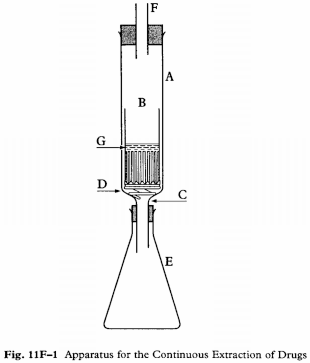Appendix XI F. Continuous Extraction of Drugs
Where the process of maceration or percolation is specified in a monograph, carry out the following procedures with any modification indicated in the monograph.
Maceration
Place the solid materials with the whole of the menstruum in a closed vessel and allow to stand for 7 days, shaking occasionally. Strain, press the marc and mix the liquids obtained. Clarify by subsidence or filtration.
Percolation
Moisten the solid materials with a sufficient quantity of the menstruum, allow to stand for 4 hours in a well-closed vessel, pack in a percolator and add sufficient of the menstruum to saturate the materials. When the liquid begins to drop from the percolator, close the outlet, add sufficient of the menstruum to leave a layer above the drug and allow to macerate for 24 hours. Allow percolation to proceed slowly until the percolate measures about three-quarters of the required volume. Press the marc, mix the expressed liquid with the percolate and add sufficient of the menstruum to produce the required volume. Clarify by subsidence or filtration.
Continuous extraction of a drug for the purpose of an assay consists of percolating the drug with the solvent stated in the monograph at a temperature approximately that of the boiling point of the solvent.
The apparatus described below, or any similar apparatus, may be used, provided that it permits the uniform percolation of the drug and the regular flow of the vapour of the solvent around the percolator.
The apparatus is shown in Fig. 11F–1. A is an outer tube of stout glass; the wider part is about 18 cm long and has an internal diameter of 4.8 to 5 cm; the lower end C is about 5 cm long and has an external diameter of about 1.6 cm. B is a straight glass tube open at both ends, about 9 cm long and with an external diameter of about 3.8 cm; over its lower, flanged end is tied firmly a piece of calico or other suitable material. D is a glass coil which supports the margin of the tube B and prevents it from resting in contact with the outer tube A. The lower end C of the outer tube A is fitted by a cork or ground-glass joint to the distillation flask E, in which a suitable quantity of the solvent has been placed. The drug to be extracted, previously moistened with the solvent or subjected to any preliminary treatment required, is introduced into the inner tube B, which is supported so that the percolate drops into the outer tube. A pad of absorbent cotton G is placed on the top of the drug, the inner tube is lowered into position and the outer tube connected by means of a suitable cork or ground-glass joint with the tube of a reflux condenser F. The flask is heated and the extraction continued as directed.
